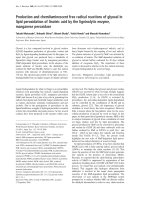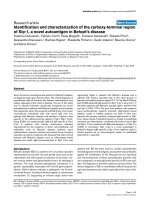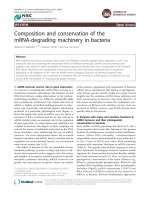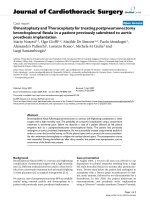Báo cáo y học: " Liver and brain abscess caused by Aggregatibacter paraphrophilus in association with a large patent foramen ovale: a case report" pps
Bạn đang xem bản rút gọn của tài liệu. Xem và tải ngay bản đầy đủ của tài liệu tại đây (597.94 KB, 4 trang )
CAS E REP O R T Open Access
Liver and brain abscess caused by
Aggregatibacter paraphrophilus in association with
a large patent foramen ovale: a case report
Shaumya Ariyaratnam
1
, Parag R Gajendragadkar
1
, Richard J Dickinson
1
, Phil Roberts
1
, Kathryn Harris
2
,
Andrew Carmichael
3
, Johannis A Karas
1,4*
Abstract
Introduction: Aggregatibacter paraphrophilus (former name Haemophilus paraphrophilus) is a normal commensal of
the oral flora. It is a rare cause of hepatobiliary or intracerebral abscesses.
Case presentation: We report a case of a 53-year-old Caucasian man with a liver abscess and subsequent brain
abscesses caused by Aggregatibacter paraphrophilus. The probable source of the infection was the oral flora of our
patient following ingestion of a dental filling. The presence of a large patent foramen ovale was a predisposing
factor for multifocal abscesses.
Conclusion: In this case report, we describe an unusual case of a patient with both liver and brain abscesses
caused by an oral commensal Aggregatibacter paraphrophilus that can occasionally show significant pathogenic
potential.
Introduction
Aggregatiba cter paraphrophilus (former name Haemo-
philus paraphrophilus) is a species of Gram-negative
coccobacilli formerly in the genus Haemophilus, now
Aggregatibacter [1]. It is a normal commensal of the
human oral cavity and pharynx. It is documented as
being a rare cause of subacute bacterial endocarditis,
brain abscess, sinusitis, arthritis and osteomyelitis and is
often associated with recent dental treatment [2]. Diag-
nosis unfortunately is hindered by its fastidious and
slow-growing nature [3].
Here we describe a rare case of a patient with both
liver and brain abscesses caused by Aggregatibacter
paraphrophilus, incidentally found to have a patent fora-
men ovale.
Case presentation
A 53-year-old Caucasian man presented with a five-day
history of malaise, productive cough, fever and rigors.
He had been treated by his prima ry care doctor for two
days with oral clarithromycin witho ut improvement. He
had undergone dental root canal surgery two m onths
previously; the dental filling fell out the day before
admission and our patient may have accidentally swal-
lowed it. He never injected drugs intravenously or
received blood transfusion. He never smoked, rarely
drank alcohol and took no other medication. On exami-
nation, he had a fever of 39°C, blood pressure of 132/68
mmHg, sinus tachycardia of 110 beats per minute. Aus-
cultation of the chest revealed some crackles at the right
lung base. His heart sounds were normal, and abdom-
inal examination was normal.
The haemoglobin level was 13.0 g/dL (mean corpuscu-
lar volume of 85fl); the platelet count was 84 × 10
9
/L;
the white cell count 10.0 × 10
9
/L, with a neutrophilia of
9.0 × 10
9
/L. The serum albumin was reduced at 29 g/L,
bilirubin 2 micromoles/L, alkaline phosphatase 466 U/L
(normal range 25 to 140) and alanine aminotransferase
239 U/L (normal range 10 to 40). The C-reactive pro-
tein (CRP) was raised a t 178 mg/ L. Serum ure a, creati-
nine, electrolytes, glucose and coagulation we re within
normal reference ranges. Urine analysis showed nitrites,
1+ protein, 1+ bilirubin, and trace blood. The ECG
showed sinus tachycardia. Chest radiography showed a
* Correspondence:
1
Department of Medicine, Hinchingbrooke Health Care NHS Trust,
Hinchingbrooke Hospital, Hinchingbrooke Park, Huntingdon, PE29 6NT, UK
Ariyaratnam et al. Journal of Medical Case Reports 2010, 4:69
/>JOURNAL OF MEDICAL
CASE REPORTS
© 2010 Ariyaratnam et al; licensee BioMed Central Ltd. This is an Open Access article distributed under the terms of the Cre ative
Commons Attribution License (http:/ /creativecommons. org/licenses/by/2.0), whi ch permits unrestri cted use, distribution, and
reproduction in any medium, provided the original work is proper ly cited.
prominent right hilum. Blood cultures taken on our
patient after admission showed no growth.
Community-acquired pneumonia was suspected for
which our patient was treated with intravenous amoxi-
cillin-clavulanic acid 1.2 g every 8 hours and oral clari-
thromycin 500 mg every 12 hours. A liver ultrasound
performed because of the abnormal liver function tests
revealed two well-defined areas of mixed echogenicit y in
the right lobe of the liver measuring 49 mm and 40 mm
in diameter. Metastatic tumor was suspected.
The fever of our patient continued, and on the third
day, he developed a severe headache with persistent
vomiting. Fundoscopy was normal. Computer tomogra-
phy (CT) scanning of the head with contrast was nor-
mal. Lumbar puncture was performed which showed no
white cells or red cells and no organisms identified on
Gram stain or upon culture of the cerebrospinal fluid
(CSF). A CT scan of the chest revealed minor basal
atelectasis. A CT scan of the abdomen and pelvis
revealed a single enhan cing low attenuation 4.5 cm
mass in the right lobe of the liver which showed some
contrast enhancement [figure 1]. The other solid organs
and appendix were normal, and a metal artefact was
seen in the colon [figure 2].
Because he was not improving, he underwent percuta-
neous aspiration of the liver lesion under ultra sound gui-
dance after six days. This drained 30 ml of pus from our
patient. Gram stain showed no organisms and culture
was negative. He continued to have upper abdominal
pain and high fever. A repeat abdominal CT scan showed
persistence of the liver abscess, and a mildly dilated
appendix (approx. 12 mm diameter). Plain abdominal
radiography confirmed a dense radio-opaque object con-
sistent with amalgam dental filling in the right lower
quadrant. A percutaneous pigtail drain was inserted and
a further 20 ml of pus was aspirated. He was treated with
intravenous ertapenem 1 g once daily and intravenous
metronidazole 500 mg three times a day.
Both samples of pus that wer e aspirated from the liver
abscess were culture negative. The causative organism
was identified as Aggregatibacter paraphrophilus by
polymerase chain reaction (PCR) amplification of the
bacterial 16S ribosomal DNA followed by nucleotide
sequencing, using published primers [4]. Serological
tests for influenza A and B, parainfluenza, adenovirus,
respiratory syncytial virus, Chlamydia, and Mycoplasma
were negative. All urine, stool, cerebrospinal fluid and
methicillin resistant Staphylococcus aureus multisite cul-
tures were negative. A trans-thoracic echocardiogram
(TTE) prior to discharge did not show evidence of
endocarditis. Repeat CT scan of the abdomen after 14
days showed improvement in the liver abscess and some
bilateral basal consolidation. The fever of our patient
was resolved. After completing 19 days of intravenous
ertapenem, it was shifted to oral amoxicillin 500 mg
every eight hours for two weeks. During discharge after
29 days, his liver function tests had returned to normal,
but he was anaemic with a haemoglobin of 10.7 g/dL,
an erythrocyte sedimentation rate (ESR) of 94 mm/hr
and CRP of 17 mg/L.
Thr ee weeks after discharge and two weeks after hav-
ing completed the course of oral amoxicillin, our patient
Figure 1 Computed tomography of the abdomen showing a
mildly enhancing peripheral hypodense lesion in liver. Scan
taken during the initial admission.
Figure 2 Computed tomography of the abdomen showing a
metallic artefact (likely dental amalgam) in appendix region.
Scan taken during the initial admission.
Ariyaratnam et al. Journal of Medical Case Reports 2010, 4:69
/>Page 2 of 4
re-presented to our hospital. Since discharge, he had
been bumping into objects on his left side and for one
day he had headache, rigors and a sore throat - he was
re-admitted on that day 51. On examination, he was
febrile with no signs of infective endocarditis. Ophthal-
mological examination revealed a left homonymous
hemianopia wit h normal fundi. Repeat blood tests
showed a haemoglobin of 11.4 g/dl (MCV 86.0fl) and a
CRP of 62 mg/L; his renal and liver function tests were
normal. A CT sca n of the head with contrast performed
on day 52 revealed multiple brain abscesses: a ring-
enhancing lesion in the left occipital lobe and a non-
enhancing low attenuation lesion in the right occipital
lobe, with no mass effect. A CT scan of the abdomen
showed a small resolving area of low attenuation in the
liver; the appendix was normal. He was treated with
intavenous meropenem 2 g every eight hours and trans-
ferred to a tertiary hospital. Magnetic resonance imaging
(MRI) of the head confirmed multiple brain abscesses;
there were multiple foc i of contrast enhancement near
the grey-white junction of both cerebral hemispheres, a
more confluent area of signal change and enhancement
was seen in the right occipital lobe, and a small enhan-
cing lesion was seen in the right cerebellar hemisphere
[figure 3].
On day 53, a mini-craniotomy and biopsy was per-
formed on a left occipital ring-enhancing lesion. On
microscopy, pus cells were seen but no organisms were
observed on gram staining, and enriched aerobic,
anaerobic and fungal cultures were negative. Results of
the 16S rDNA PCR of the brain abscess biopsy again
detected the sequence of Aggregatibacter paraphrophi-
lus. Histopathology showed appearances typical of a
brain abscess. A trans-oesophageal echo performed on
day 55 show ed no evidence o f endocarditi s but there
was evidence of a patent foramen ovale (PFO) and an
atrial septal aneurysm. A bubble echo was performed
on day 60; during provocation by Valsalva maneuver,
there was a large right-to-left shunt through the patent
foramen ovale. Ultrasound scanning of the liver showed
no remaining collection. Maxillo-facial assessment
including dental panoramic tomography revealed no
ongoing dental infection. His immunoglobulins were
normal, anti-nuclear antibody and an ti-neutrophil cyto-
plasmic antibody negative, and serologica l tests for
human immunodeficiency virus, syphilis and toxoplasma
were negative. He continued treatment with intravenous
meropenem 2 g every eight hours and oral metronida-
zole 400 mg every eight hours added on day 54, and
remained afebrile. He was discharged on day 65 since
first presentation (white cell count 7.3 × 10
9
/L and CRP
5 mg/L) with intravenous ceftriaxone 2 g every
12 hours to complete four weeks of out-patie nt antibio-
tics via a peripherally inserted central line.
Follow-up CT scan of the head on day 71 showed sur-
gical changes deep to the left occipital craniotomy;
resolving right frontal and left occipital lobe abscesses;
and a large hypodense area in the right occipital lobe in
keeping with an established occipital infarct. Follow-up
cranial MRI on day 81 revealed improvement in the size
of the multiple small enhancing subcortical white matter
lesions (likely microabscesses); with persistence of the
right occipital infarct.
On outpatient follow-up, intravenous antibiotics were
extended to complete a six week course in total; our
patient w as then switched to oral amoxicillin-clavulanic
acid 625 mg every eight hours for a duration of two
weeks. Unfortunately, his left homonymous hemianopia
persisted.
Cardiology follow-up concluded that it was prudent to
close the PFO as there was a possibility of further para-
doxical emboli and this is planned. Our patient was put
on anti-coagulant and anticonvulsant therapy and a cra-
nial MRI on day 137 has show n further improvement of
the cerebral abscesses.
Conclusion
In this case, we highlight the potential for Aggregatibac -
ter paraphrophilus to cause widespread systemic infe c-
tions especially following dental treatment. Given the
fastidious nature of the organism [3], it also emphasizes
the value of bacterial 16S rDNA PCR amplification and
sequencing in identifying bacteria in abscesses which are
Figure 3 T1 weighted magnetic resonance imaging of the
head showing multiple foci of contrast enhancement
(abscesses). Scan taken during the second admission showing
lesions suspicious of abscesses near the grey-white junction of both
cerebral hemispheres, and a small enhancing lesion in the right
cerebellar hemisphere.
Ariyaratnam et al. Journal of Medical Case Reports 2010, 4:69
/>Page 3 of 4
culture-negative as a result of prior antibiotic adminis-
tration [4].
Following the root canal surgery, our patient may have
developed bacterial endocarditis related to his atrial sep-
tal aneurysm and patent foramen ovale, but it was not
possible to confirm this because he received treatment
with antibiotics before blood cultures were taken.
Minor, unrecalled trauma to the liver has been
described in the literature as a predisposing factor for
localisation of infection [5] and the presence of the den-
tal filling in the colon may have given rise to the portal
bacteraemia. We suspect that the shunt through the
patent foramen ovale was a contributory factor in the
development of the multiple brain abscesses by permit-
ting infected material to bypass the lungs and enter the
systemic circulation. The foramen ovale s erves as a
shunt during intrauterine life and occludes after birth
with closure becoming anatomic over time. It remains
patent in a small proportion of the population and is
associated with embolic stroke. The association with
cerebral abscess is less strong and reported only in a
low number of case reports in the literature [6,7].
Another c ontributing factor in our patient developing
brain abscesses may have been the fact that he was trea-
ted with ertapenem for his initial liver abscess. Ertape-
nem, unlike meropenem, is not licensed for treatment of
meningitis as it exhibits wide variability in CSF/plasma
ratios that preclude its use in CSF infections [8,9].
Consent
Written informed consent was obtained from our
patient for publication of this case report and any
accompanying images. A copy of the written consent is
available for review.
Acknowledgements
Department of Microbiology, Great Ormond Street Hospital for Children,
London, UK for identification of isolates
Author details
1
Department of Medicine, Hinchingbrooke Health Care NHS Trust,
Hinchingbrooke Hospital, Hinchingbrooke Park, Huntingdon, PE29 6NT, UK.
2
Department of Microbiology, Level 4 Camelia Botnar Laboratories, Great
Ormond Street Hospital for Children NHS Trust, Great Ormond Street,
London, WC1N 3JH, UK.
3
Department of Infectious Diseases, Addenbrooke’s
Hospital, Cambridge University Hospitals NHS Foundation Trust, Hills Road,
Cambridge, CB2 0QQ, UK.
4
Health Protection Agency, East of England,
Microbiology Laboratory, Papworth Hospital, Ermine Road, Papworth Everard,
CB23 3RE, UK.
Authors’ contributions
SA, PG, RD, PR, AC, JK for clinical, and KH for laboratory work, all contributed
to writing the article. All have read and approved the final manuscript
Competing interests
The authors declare that they have no competing interests.
Received: 29 September 2009 Accepted: 24 February 2010
Published: 24 February 2010
References
1. Nørskov-Lauritsen N, Kilian M: Reclassification of Actinobacillus
actinomycetemcomitans, Haemophilus aphrophilus, Haemophilus
paraphrophilus and Haemophilus segnis as Aggregatibacter
actinomycetemcomitans gen. nov., comb. nov., Aggregatibacter
aphrophilus comb. nov. and Aggregatibacter segnis comb.nov., and
emended description of Aggregatibacter aphrophilus to include V factor-
dependent and V factor-independent isolates. Int J Syst Evol Microbiol
2006, 56(Pt 9):2135-46.
2. Huang ST, Lee HC, Lee NY, Liu KH, Ko WC: Clinical characteristics of
invasive Haemophilus aphrophilus infections. J Microbiol Immunol Infect
2005, 38(4):271-276.
3. Chadwick PR, Malnick H, Ebizie AO: Haemophilus paraphrophilus infection:
a pitfall in laboratory diagnosis. J Infect 1995, 30(1):67-69.
4. Harris KA, Hartley JC: Development of broad range 16S rDNA PCR for use
in the routine clinical microbiology service. J Med Microbiol 2003,
52:685-691.
5. Haight DO, Toney JF, Greene JN, Sandin RL, Vincent AL: Liver abscess
following blunt trauma: a case report and review of the literature. South
Med J 1994, 87(8):811-813.
6. Kawamata T, Takeshita M, Ishizuka N, Hori T: Patent foramen ovale as a
possible risk factor for cryptogenic brain abscess: report of two cases.
Neurosurgery 2001, 49:204-207.
7. Stathopoulos GT, Mandila CG, Koukoulitsios GV, Katsarelis NG,
Pedonomos M, Karabinis A: Adult brain abscess associated with patent
foramen ovale: a case report. J Med Case Reports 2007, 1:68.
8. Data sheet for ertapenem sodium. Medsafe - New Zealand Medicines and
Devices Safety Authority [ />Invanzinj.htm].
9. Nau R, Lassek C, Kinzig-Schippers M, Thiel A, Prange HW, Sörgel F:
Disposition and elimination of meropenem in cerebrospinal fluid of
hydrocephalic patients with external ventriculostomy. Antimicrob Agents
Chemother 1998, 42(8):2012-2016.
doi:10.1186/1752-1947-4-69
Cite this article as: Ariyaratnam et al.: Liver and brain abscess caused by
Aggregatibacter paraphrophilus in association with a large patent
foramen ovale: a case report. Journal of Medical Case Reports 2010 4:69.
Submit your next manuscript to BioMed Central
and take full advantage of:
• Convenient online submission
• Thorough peer review
• No space constraints or color figure charges
• Immediate publication on acceptance
• Inclusion in PubMed, CAS, Scopus and Google Scholar
• Research which is freely available for redistribution
Submit your manuscript at
www.biomedcentral.com/submit
Ariyaratnam et al. Journal of Medical Case Reports 2010, 4:69
/>Page 4 of 4









